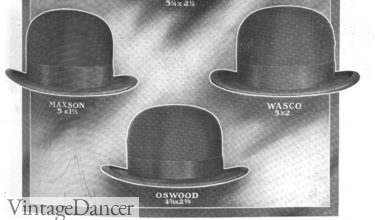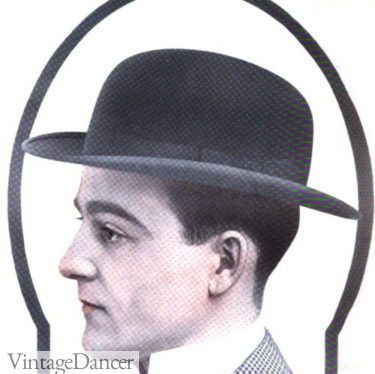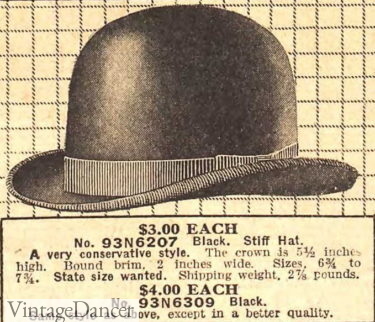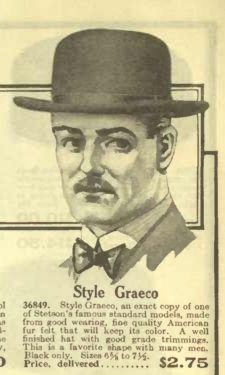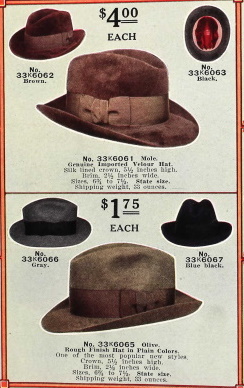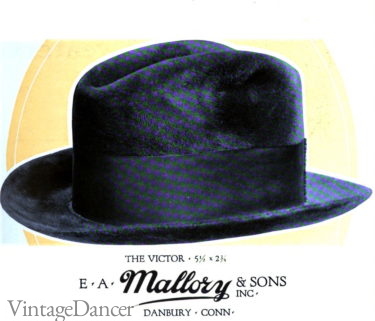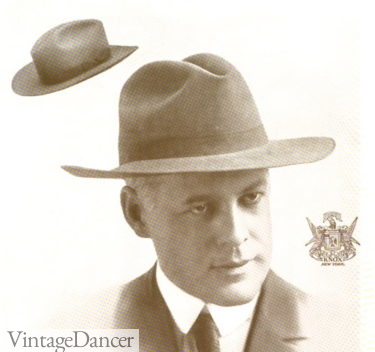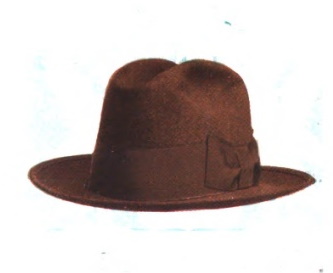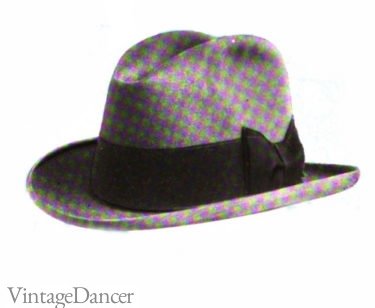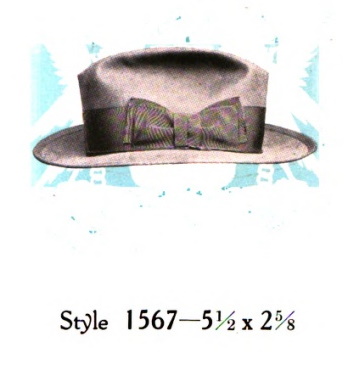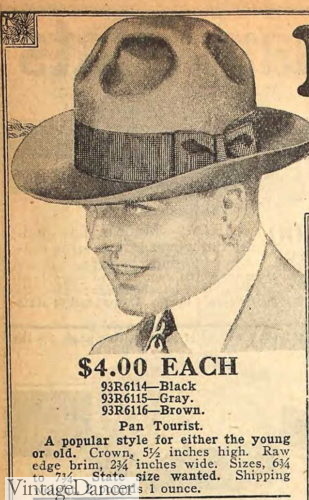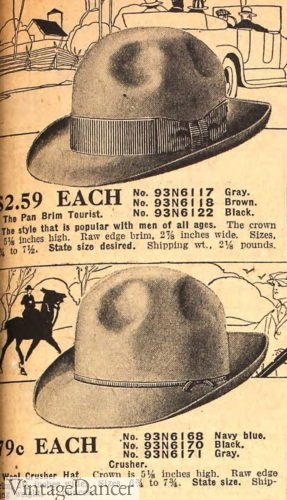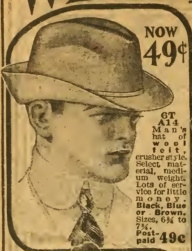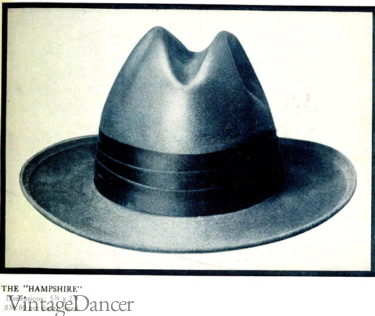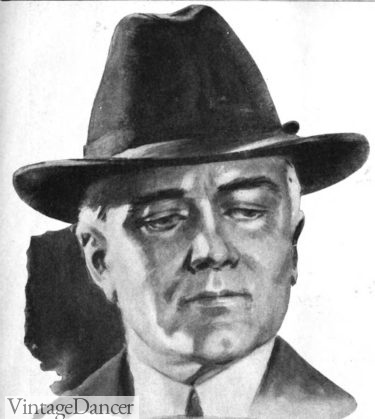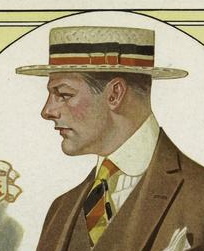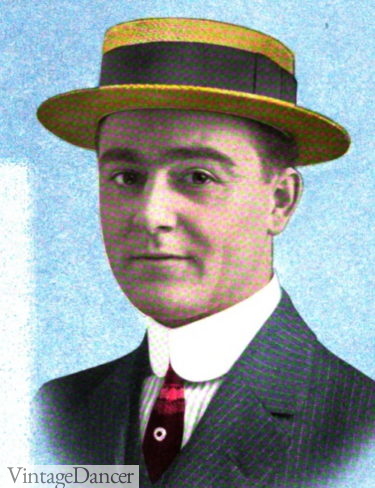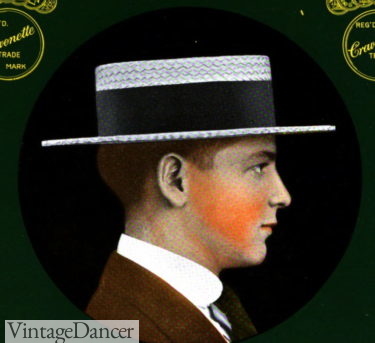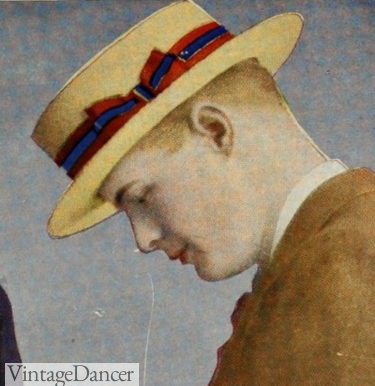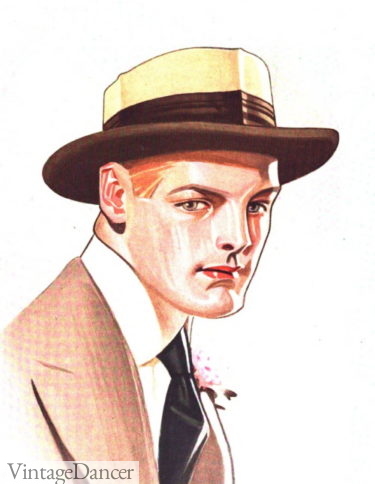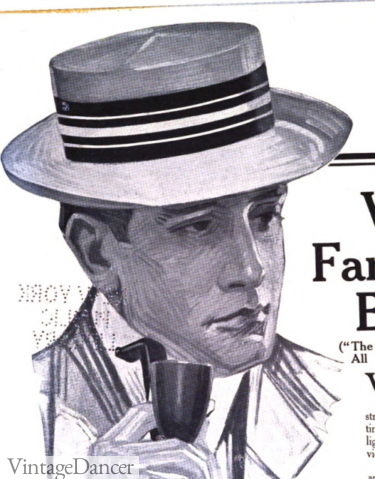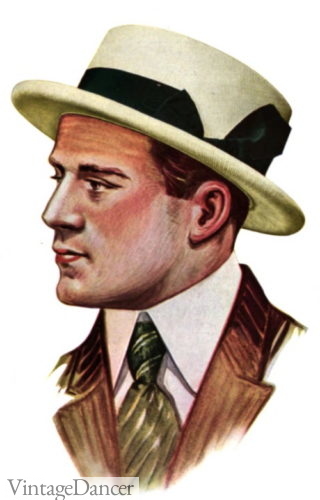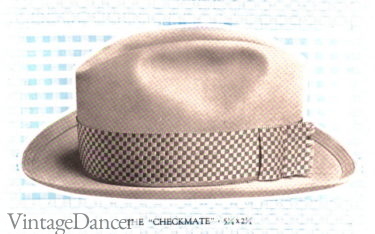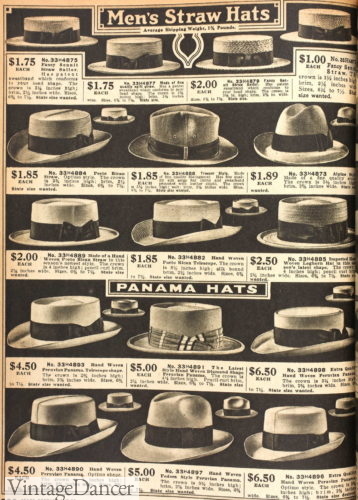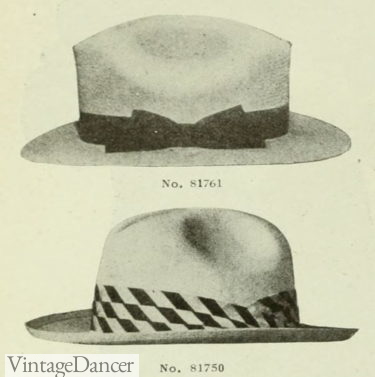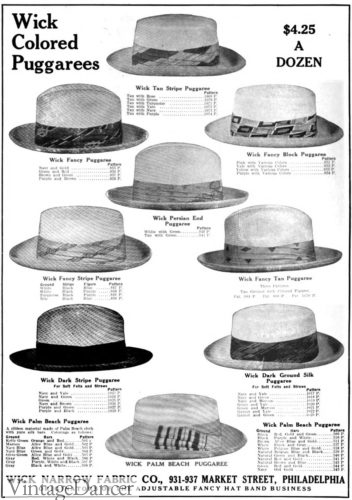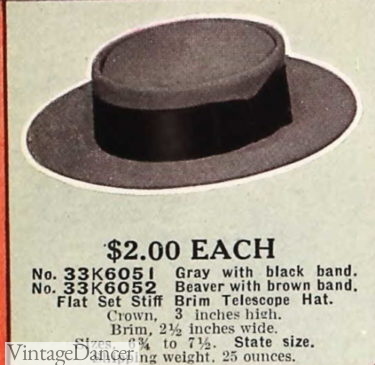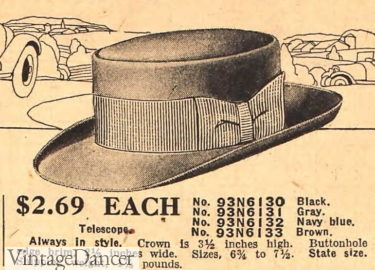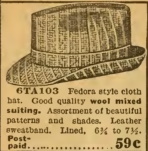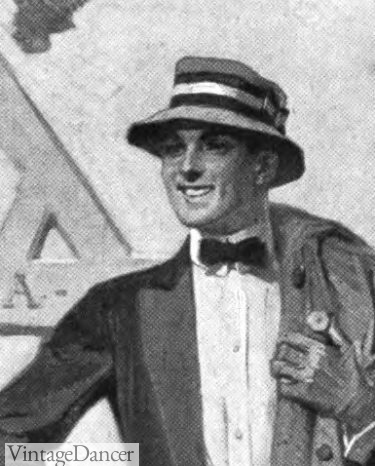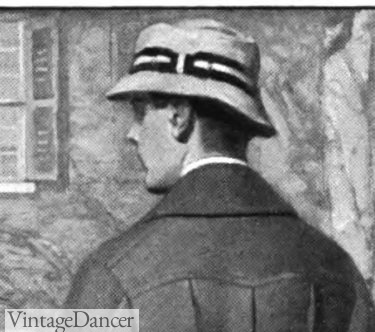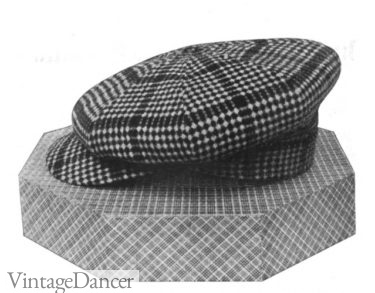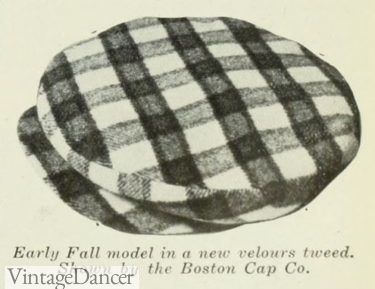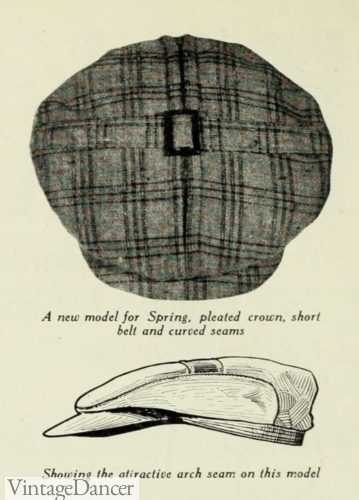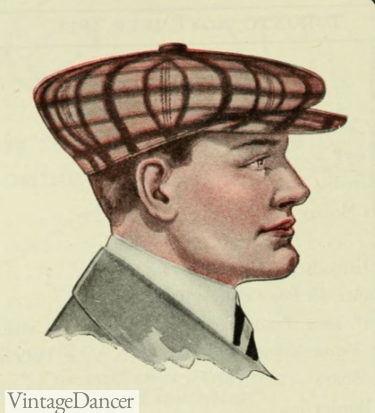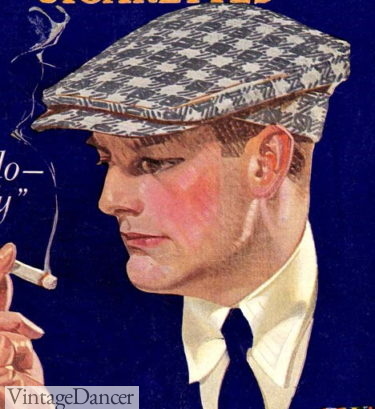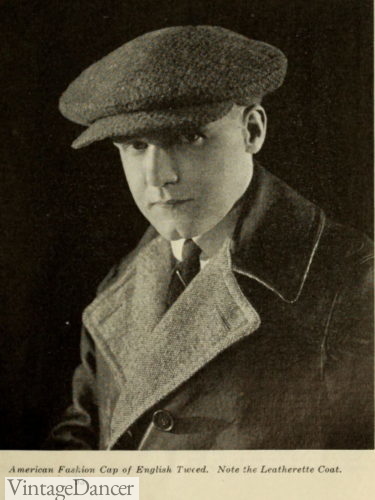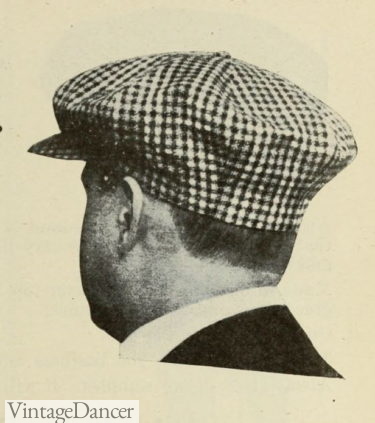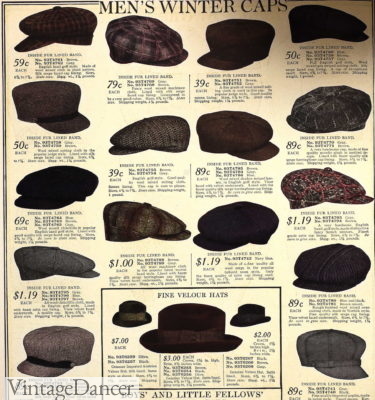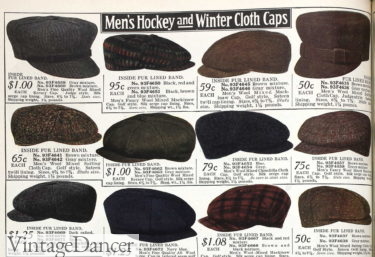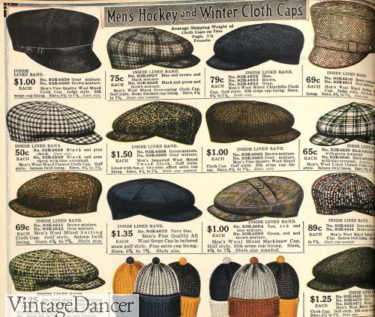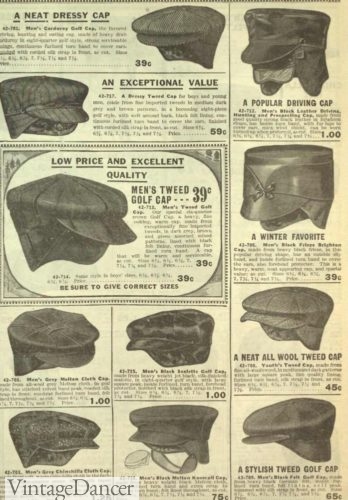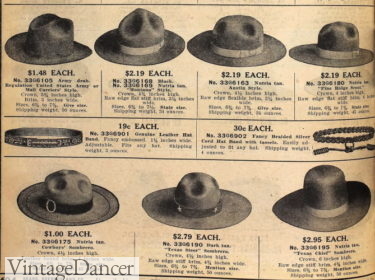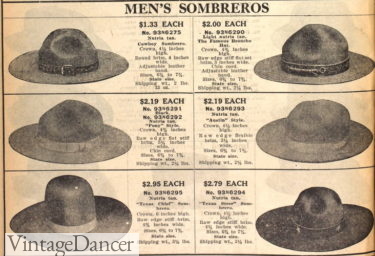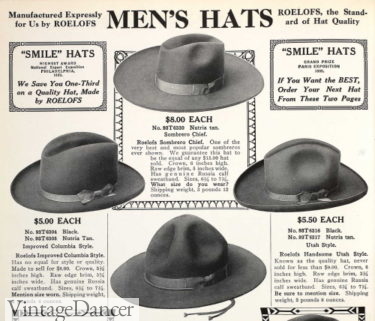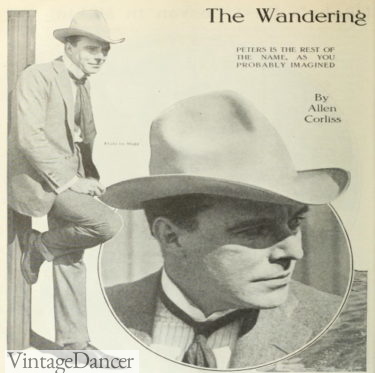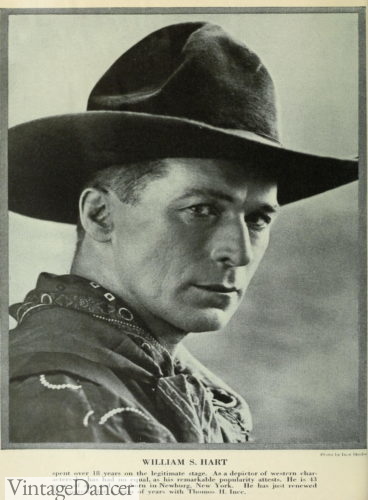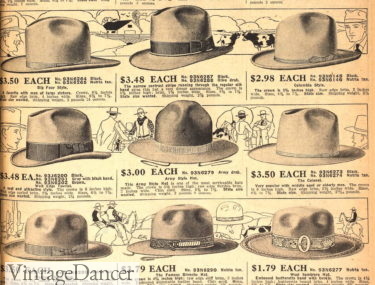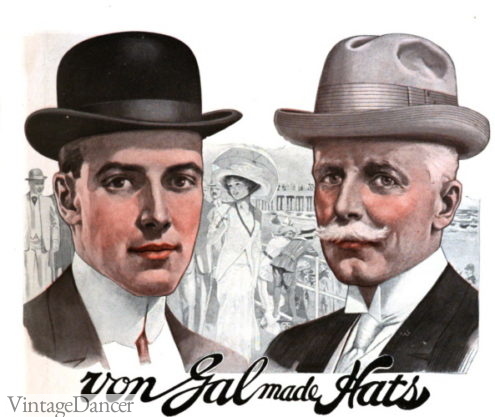
1913 Men’s Derby Hat and Fedora Hat
Men’s hats in the 1910s followed the same shapes and colors as the 1900s decade. Big changes, however, would come in the later years during and after WWI.
Derby Hats
The classic businessman’s round Derby hat (bowler hat) remained unchanged. Black was worn year round. Brown in Autumn, grey in spring and summer. Sizes shrunk slightly: 4 – 1/2 to 5 – 1/4 inches tall with a 2″ brim, give or take a half inch. As the years progressed, American men discarded the derby altogether in favor of the soft felt hat.
- 1911 Various Sized Derby Hats
- 1912 Short Crown Derby
- 1918 Tall Crown Derby Hat
- 1918 Derby Hat with Wide Brim
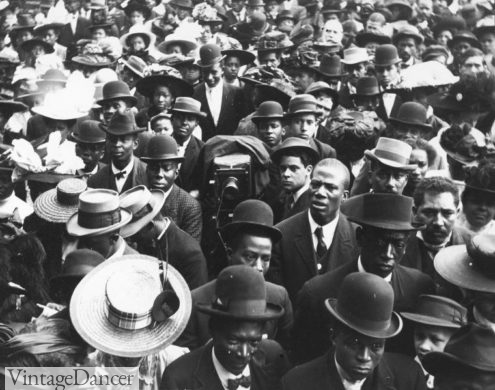
A Mix of Derby and Straw Hats
Homburg Hats
The homburg was gradually replacing the Derby hat for businessmen in the city. It was made of a stiff fur felt and had a domed oval shape, with rolled edges all around. The American version had softer rolls and shorter crown than the British version.

1910s Homburg Hat
Fedora Hats
Fedora, tourist hat, and trooper hat were names used interchangeably to describe soft felt hats in a general fedora shape. They had an indented or pinched crown with raw, welt, or curled edges and snap or straight brims. Most brims were around 2 – 1/2 inches wide and 4 – 1/2″ to 5 – 1/2″ tall.
Snap brim fedoras replaced the curled brim fedoras of the the 1900s. The wide flat brim could be snapped up or down in the front, back, or sides. American men liked having the option to shape his hat any way that suited him.
Fedora hat colors were grey, black, blue-black, brown, light brown, olive green, ivory, and navy blue. Hats bands matched, were slightly darker in color, or were black. Dressy hats had wide hat bands, while sporty or casual hats could have thin leather bands.
- 1912 Fedora Hats
- 1913 Brushed Fur Felt Fedora Hat
- 1916 Men’s Wide Snap Brim Fedora Hat
- 1916 Knox Brown Fedora
- 1916 Knox Fedoras
- 1916 Soft Fedora
- Pinched Fedora Hat
- 1918 Tourist or Crusher Fedoras
- 1915 Crusher Fedora
The height of the fedora crown grew taller as the decade inched towards the Roaring Twenties. 5 – 1/2″ tall crowns were the standard height by 1919. To keep them in balance, brims also grew a little wider, going from 2 1/2 to 3 inches.
The Alpine fedora was one of the tallest shapes, with unique sloped sides that peaked to a dented mountain top. It was a short lived fad.
- 1917 Alpine Fedora
- 1919 Alpine Fedora
Boater Hats
The ideal summer hat had the boater silhouette: stiff, oval crown hat with flat top and flat brim. It was accompanied by a striped or solid grosgrain hat band and bow. The straw could be a heavy textured weave or a fine Panama in shades ranging from yellow to white.
- 1910 Short Boater Hat
- 1913 Straw Boater with Black Hat Band
- 1916 White Boater Hat
- 1919 Panama Boater Hat
Straw and Panama Hats
Besides the boater hat, men wore all kinds of oval crown or “telescope” crown hats made of straw. The brims on these hats were slightly rolled up all around. By the end of the decade, designers were playing with only side rolls or back rolls with a front dip.
The fedora-style Panama straw hat, with center dent crown, was also starting to come into fashion during this decade. Hat bands were quite wide, with the new pleated Puggarees hat band in novelty patterns being favored by snappy young men.
- 1915 Optimo Panama Hat
- 1910 Telescope Straw Hat
- 1914 Curled Brim Telescope Hat
- 1913 Straw Fedora Hat with Checkered Hat Band
- 1917 Men’s Straw Hats and Panama Hats
- 1918 Fedora Straw Hats with Bow or Pleated Band
- 1917 Patterned Hat Bands
Telescope crown hats with variously shaped brims were also made in felt for the cooler seasons. These hats would later be known as Pork Pie hats. Some hats had a flat 2 – 1/2″ brim while others had a snappy shaped brim upturned in the back. The flat top had a crease around the inside edge. A very wide hat band and bow in black paired with each hat.
They were poplar with motorists, young men, artists, and other un-conservative types.
- 1912 Telescope Crown Black or Brown Felt Hat
- 1918 Telescope Crown with Shaped Brim
Cloth Hats
Cloth hats were ideal for workwear, sportswear, and among the poor. Cheap and lightweight, they could be crushed easily without damage, washed, and replaced when necessary. They were a novelty idea until the later half of the decade.
Similar to bucket hats, cloth hats had domed crowns with a brim that could roll up in the back, or had a center crease crown similar to a fedora. Most hats had contrast stitching along each sewn panel.
In summer, fabrics were light linen, cotton, silk taffeta, and light wool. In winter there were heavier coat type wools, wool suiting, and faux plush fur.
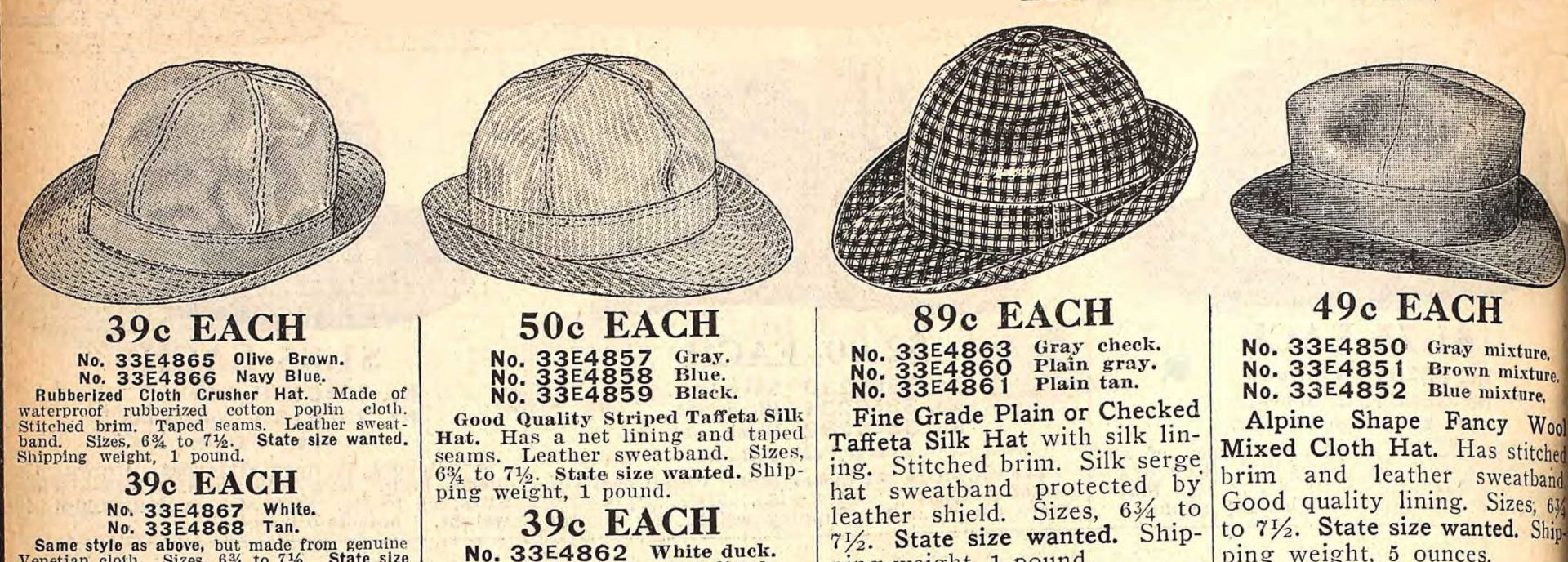
1916 Men’s Cloth Hats
- 1915 Tan Linen Summer Hat
- 1915 Wool Suiting Striped Fedora

1912 Men’s Wool Cloth and Fur Hats
One other style of cloth hat you may be surprised to see this early in the century was the bucket hat. It was a brief novelty with young men who wore them with Norfolk suits and even tuxedos! This cotton cloth hat with crumbled, downturned brim and striped hat band would come back again decades later in the 1960s.
Golf Caps
Navy, grey, blue, black, olive, brown. Black and white checks and large plaids. They had it all. Men’s sport caps were stand out pieces of color and pattern. The fit was also wide and flat on the head. They could be sewn with one piece on top or in 8 triangle panels. The brim was stiff and wide, too. Winter caps had built-in ear flaps that could either snap up out of the way or down to keep ears warm.
Work Caps / Winter Caps
There were many types of work caps or winter sport caps that were worn by the working classes. The above golf cap was the only one to cross over into the upper-class wardrobe.
Some of the styles names are were Quebec (laced in front), Brighton cap (similar to Quebec – no laces or faux bows), Engineer’s cap (Train work), Storm cap, Judge, Havelock, Detroit, Hunters, and Bismarck. Materials were sturdy wool, corduroy, or even straw.
- 1912
- 1914
- 1916
- 1917
- 1911 Work Caps
- 1913 Work Caps
Western Hats
Each Western or Sombrero hat style had an associated region they were named after: Montana, Austin, Columbia, Pine Ridge Scout, Texan, Calvary, The Big Four, Bronco, Lennox, Dakota, and Pony.
Brims were up to 6 inches wide and 4 inches tall. The crowns were punched in various places with a wide grosgrain hat band or braided hat band.
Western hats by the end of decade were looking more formal, more like Fedora hats, and less like working class rough hats.
- 1911 Western Hats
- 1913 Western Hats
- 1914 Western Hats
- 1917 Western Hats
- 1917 Western Hats
- 1918 Western Hats
Shop 1910s inspired men’s hats here.
Debbie Sessions has been teaching fashion history and helping people dress for vintage themed events since 2009. She has turned a hobby into VintageDancer.com with hundreds of well researched articles and hand picked links to vintage inspired clothing online. She aims to make dressing accurately (or not) an affordable option for all. Oh, and she dances too.
